1
First British Unit ExchangeIn report to the Minister of militia and Defence dated December 1897, details the first known exchange between Canadian and British units. A company of the Royal Berkshire Regiment stationed in Halifax was exchanged with a company with the Royal Regiment of Canadian Infantry for a 6 month period and conducted their depot training in Camp Sussex in the summer of 1897. This practise would not occur again for a number of years even though it was considered a huge success.
The report went on to state that this was seen as an opportunity to strengthen the current forces and to provide access to more modern armaments of the British units. The next focus would be an exchange between artillery units particularly of those in Quebec, where it appears that modern artillery was lacking.
2
Coronation of King George V - The Militia Orders detailed the expected response from all units in Canada to mark the coronation of King George V on 22 June 1912. At precisely 1200 hr local time all available units were to muster for formal reviews and to fire a "feu de jouie" or loosely translated a "fire of joy". The response in Camp Sussex resulted in a formal parade from a number of units and the guns proceeded to conduct the feu de jouie with each guns firing rounds in sequence to a maximum of three rounds per guns. All men were expected to volunteer and most local units complied including the Artillery, the 74th Battalion and the Hussars.The presentation of colors to the New Brunswick Rangers -1938
Visit of the Ambassador of the Netherlands - 1952
3
Coronation Day22 June 1911
Sussex, New Brunswick, Canada
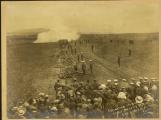 Credits:
Credits:Gary Bowser
Annual Report, Department of Militia and Defence of the Dominion of Canada
4
74th Battalion on Coronation Day, June 191122 June 1911
Sussex, New Brunswick, Canada
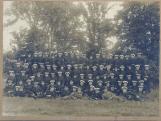 Credits:
Credits:Gary Bowser
Annual Report, Department of Militia and Defence of the Dominion of Canada
A Historical Outline, The New Brunswick Rangers
5
Church ParadeCirca 1910
Sussex, New Brunswick, Canada
 Credits:
Credits:Kings County Historical Society
Annual Report, Department of Militia and Defence of the Dominion of Canada
6
At wars end, the 8th Hussars were stationed in a number of towns in Holland awaiting repatriation to Canada. One such town was Eelde, which forged a special bond with the Regiment between April and November 1945, while they were stationed there. While there a hand sewn flag was made including both the Hussar hat badge anf the towns emblem and flown at the town hall. It was given to the Regiment at the close of their time there. Upon departure the town council also presented the Hussars with a parchment expressing their thanks, including a promise that some day they would present the Regiment with a gold medal, once they could recover what had been stolen by the occupying forces. That day would occur in May 1952 when the Dutch ambassador to Canada came to Sussex to present the promised gold medal. Both the medal and the flag are displayed in the Hussar Museum in Sussex, NB.7
Dutch Ambassador Reviews the Troops25 May 1952
Sussex, New Brunswick, Canada
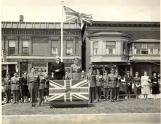 Credits:
Credits:Association of the 8th Canadian Hussars (Princess Louise's) Inc
Crook and Marteinson, A Pictorial History of the 8th Canadian Hussars (Princess Louise's)
Howe, Douglas, The 8th Hussars, A History of the Regiment
8
The Dutch Ambassador Reviewing the Troops25 May 1952
Sussex, New Brunswick, Canada
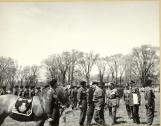 Credits:
Credits:Howe, Douglas,The 8th Hussars, A History of the Regiment
Crook and Marteinson, A Pictorial History of the 8th Canadian Hussars (Princess Louise's)
9
Gold Medal Dedication Service25 May 1952
Sussex, New Brunswick, Canada
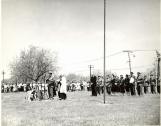 Credits:
Credits:Crook and Marteinson, A Pictorial History of the 8th Canadian Hussars (Princess Louise's)
Howe, Douglas,The 8th Hussars, A History of the Regiment
Association of the 8th Canadian Hussars (Princess Louise's) Inc